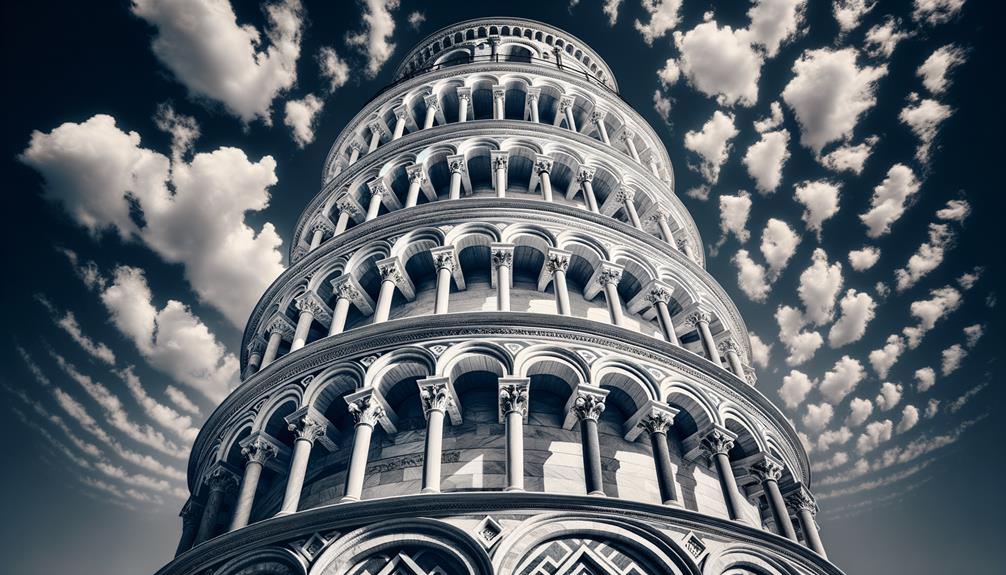Seeing the Leaning Tower of Pisa for the first time felt like peering into history through a tilted viewfinder. This remarkable building, with its gentle yet obvious lean, tells a tale of ambition, missteps, and determination. Construction began in 1173 and stretched over almost two centuries. It's impressive how its Romanesque style, featuring graceful arches, has weathered the years and the elements. You might wonder what caused its famous tilt and how it's remained standing despite many challenges. The answers are surprising, each fact adding another layer to its captivating history.
History and Construction
The Leaning Tower of Pisa's construction started back in 1173 and stretched over nearly 200 years, often halted by conflicts between Italian city-states. From the beginning, it was intended to be an incredible free-standing bell tower that would demonstrate the skill of its builders. But little did they know, the soft ground it was built on would give it its famous tilt.
It's fascinating to think that the tower began leaning as early as the late 1170s, after just three stories were up. Imagine the stress for those early engineers, realizing their grand project was shifting because the foundation was only three meters deep. The ground, made up of clay, sand, and shells, was a tough opponent, causing the tower to tilt.
The stops in construction weren't just because of the wars; they also involved efforts to fix the lean. Clever tactics, like making the higher stories taller on one side, were attempted but didn't work. Despite these efforts, the Tower of Pisa continued to lean, turning it into the iconic structure we know today.
Architectural Design
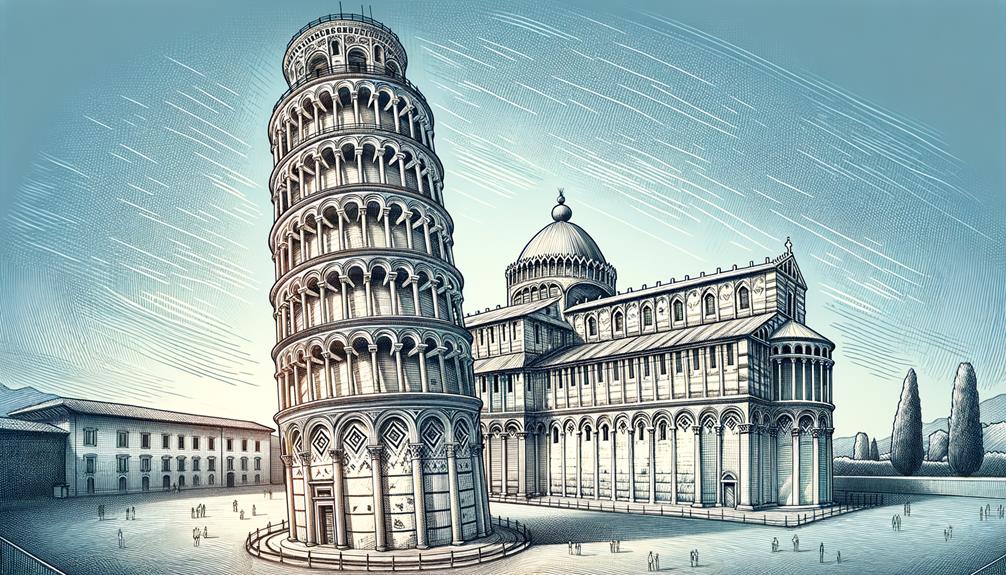
As we admire the Leaning Tower of Pisa's famous tilt, it's also worth noting the intricate medieval Romanesque design that defines its architectural beauty. This style, popular during the period it was built, is known for its sturdy and grand structures. Giovanni di Simone and Bonanno Pisano were key figures in its construction, although recent studies suggest Diotisalvi might have been the original designer.
Made from bright white marble, the tower's facade showcases the incredible skill of its artisans. Each level features a series of blind arches and columns that give it an elegant yet imposing look. Inside, a spiral staircase with 257 steps leads to the top, offering a unique experience of the tower's vertical journey.
Originally planned as a free-standing bell tower, the structure was meant to match the grandeur of Pisa's Cathedral Square. However, its foundation, only three meters deep, was not enough to support its ambitious height. This design flaw, while unintentional, adds to the tower's distinctive character and mystery, attracting visitors from around the world to see this architectural wonder up close.
Leaning Phenomenon
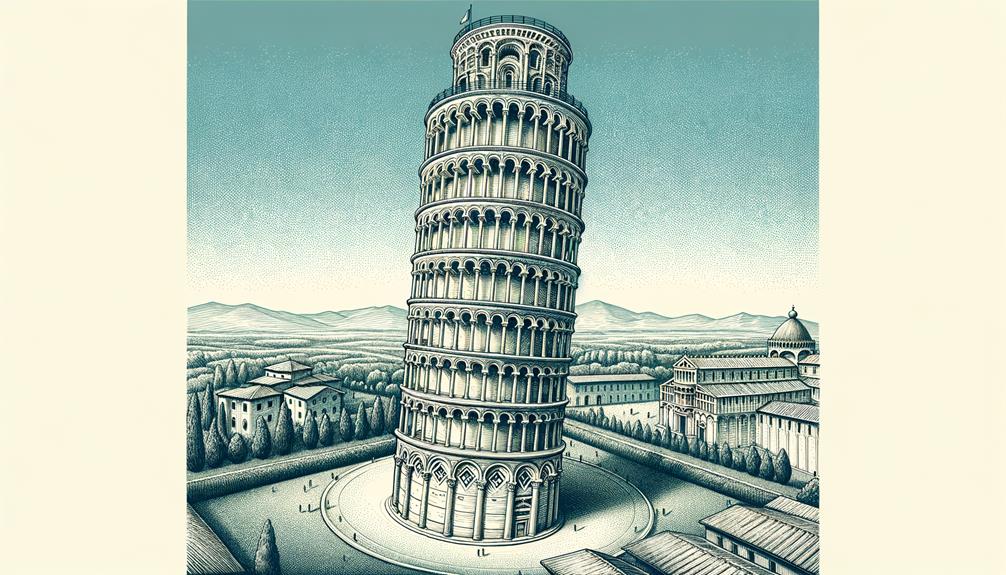
The Leaning Tower of Pisa's famous tilt, due to its unstable foundation on soft ground, has intrigued engineers and tourists for centuries. When construction began in 1173, the original plans didn't account for the soil's inability to hold the tower's weight. By the time the third story was added, the tower began to sink on one side, creating its well-known lean.
Over the years, many efforts have been made to preserve and stabilize the tower.
Medieval Fixes: Builders attempted to correct the tilt by adding taller columns and arches on the sinking side, but the lean persisted.
20th-Century Repairs: In the 1990s, engineers undertook significant work to reduce the tilt by removing soil from under the higher side, making it safer for visitors.
Modern Efforts: By 2001, the tilt was reduced by 17 inches (44 centimeters), and the tower was declared stable, ensuring its preservation for future generations.
Ongoing Monitoring: Continuous checks ensure the tower remains stable, showcasing both historical techniques and modern engineering.
Standing beneath this marvel, one can't help but feel a sense of awe, knowing it defies the odds every day.
Dimensions and Height
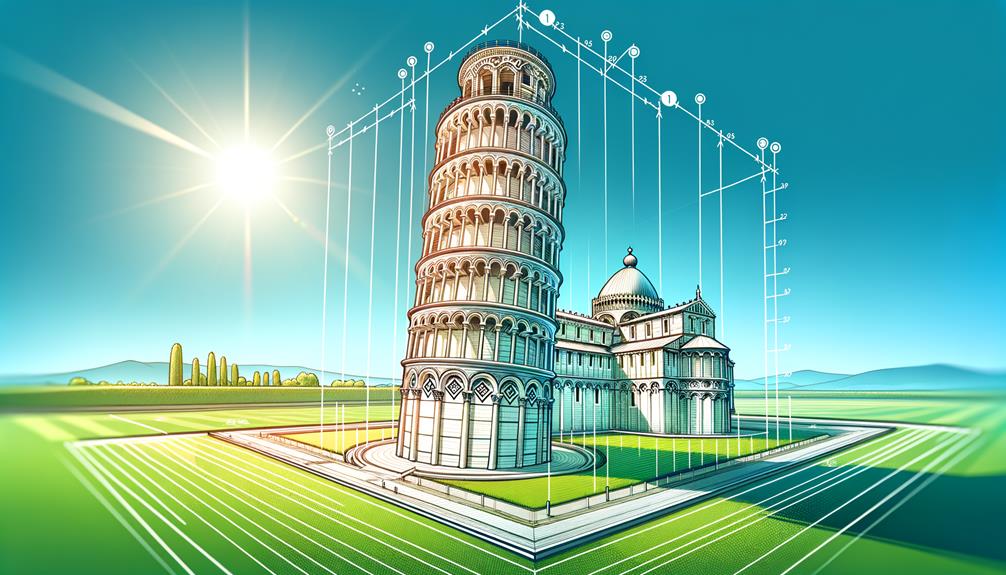
Standing tall despite its lean, the Leaning Tower of Pisa reaches about 183 feet (56 meters) from the ground on the low side to the top of its bell tower. Up close, you can really see the difference between the lowest and highest sides, making the tilt all the more impressive.
As you look at the Tower's height, each tier of arches and columns adds to its beauty. Climbing it feels like a walk through history, with every step offering a new perspective. There are 294 steps to the top, and while that might sound daunting, the view over Pisa and its surroundings is worth it.
From the lowest side, where the lean is most pronounced, to the highest side, the architecture never fails to impress. The precise engineering and artistic design are evident in every stone. This isn't just a tower; it's a testament to human creativity and the spirit of embracing the unusual. The Tower's height and lean make it a symbol of resilience and freedom.
Staircases and Bells
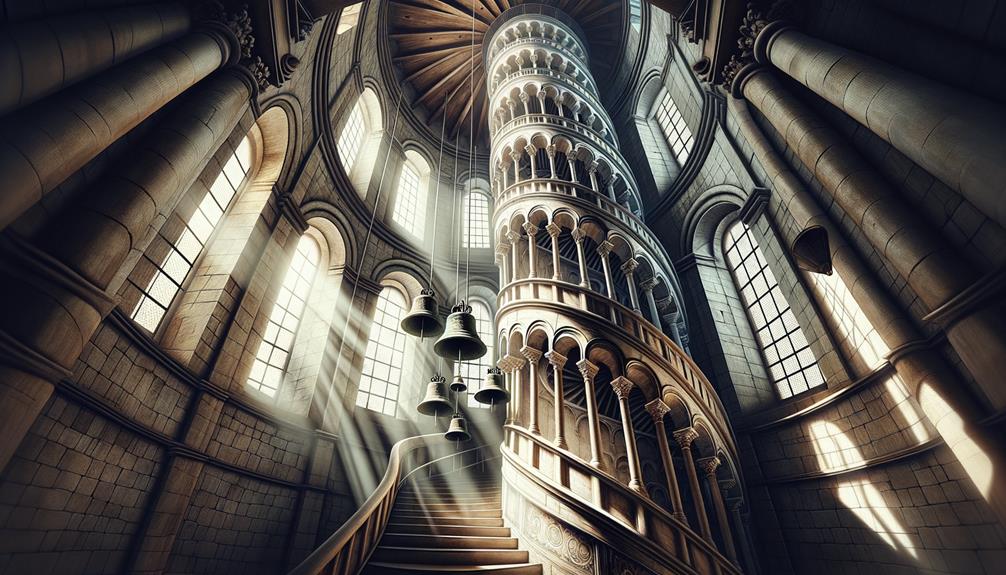
As I climbed the spiral staircase of the Leaning Tower, the 294 steps seemed to twist endlessly upward. Each step brought me closer to the historic bell chamber, where the bells have tolled through Pisa's history for centuries. The intricate design of the staircases and the stories behind the bells create a fascinating blend of architecture and tradition.
Spiral Staircase Design
Winding its way up through the ancient stone, the spiral staircase of the Leaning Tower of Pisa offers a close-up look at medieval engineering and architectural skill. The design of this staircase is both practical and beautiful, showcasing the creativity of the time. As I climb, each step seems to tell a story from the past, particularly about the periods when construction resumed after delays, blending history with every turn.
The spiral staircase is more than just a way to reach the top; it's a journey through history. The narrow steps, worn down by countless feet over the centuries, lead me upward, highlighting the tower's endurance despite its famous tilt. The seven bells at the top add a charming musical touch, each with its unique tone, representing the tower's perfect mix of form and function.
- Whispers of History: Each step brings to life the stories from when construction picked up again in the 14th century.
- Architectural Genius: The spiral staircase is a standout example of medieval craftsmanship.
- Sensory Experience: The seven bells provide a rich auditory backdrop to the visual journey.
- Timeless Journey: The Leaning Tower of Pisa's staircase invites you to walk through history, one step at a time.
Number of Steps
As I count each step on my way up, the Leaning Tower of Pisa's staircase reveals its full height with 294 steps to the top. Each step carries a piece of history, and I feel a growing sense of liberation as I climb higher. The stone steps, worn down by countless visitors over the centuries, twist their way up the tower. It's a unique experience, feeling the tilt of the tower with every step, a gentle reminder of its famous lean.
The climb, though physically challenging, feels like a journey through time at one of the world's most iconic landmarks. When I pause to catch my breath and look out the narrow windows, the Piazza dei Miracoli spreads out below, with the cathedral and lush green lawns in view. As I get closer to the top, the staircase narrows, adding to the excitement.
Finally reaching the top, I'm greeted with stunning views of Pisa and beyond. The number of steps, initially daunting, turns into a proud symbol of persistence and the human spirit's drive to explore and discover.
Bell Chamber History
When you step into the bell chamber, the grandeur of the seven historic bells immediately grabs your attention. Each bell has its own name and distinct tone, having rung out over Pisa for centuries. Walking up the bell tower, which started leaning during its construction, is an adventure packed with stories and architectural wonders.
Standing among these bells, I can't help but recall Michele dei Scalzi, who was crucial in the tower's early construction. His vision, along with the later work of Giovanni Pisano, shaped this iconic landmark. Climbing the winding staircases feels like stepping back in time, a tribute to the ingenuity and perseverance of these architects.
When visiting the bell chamber:
- Historic Bells: Seven unique bells have been ringing since the 17th century.
- Staircase Adventure: Climbing the 294 steps is challenging yet exhilarating.
- Architectural Significance: Learn about the contributions of Michele dei Scalzi and Giovanni Pisano.
- Breathtaking Views: Enjoy panoramic vistas of Pisa, making the climb worthwhile.
The bell tower, despite its lean, stands as a testament to human creativity and resilience.
Conservation Efforts

In recent years, a lot of effort has gone into stabilizing the Leaning Tower of Pisa to keep it from tilting further and ensure it stands for many more years. The work done here has been truly impressive. Walking around the base, I couldn't help but admire the clever solutions and dedication that have gone into preserving this famous structure.
The tower was once at serious risk of falling, but thanks to careful conservation efforts, it's now more stable than ever. Engineers and architects teamed up to address the lean by using innovative methods like soil extraction beneath the tower and installing counterweights. Their hard work means the tower should remain secure for at least a couple more centuries.
Looking at the tower now, I see more than just an architectural wonder. It's also a testament to human perseverance and creativity. The effort to save the tower has kept a piece of history intact for future generations to appreciate. It shows that even when faced with huge challenges, we have the ability to protect and sustain our cultural heritage. The Leaning Tower of Pisa stands as a symbol of resilience and ingenuity.
Earthquake Survival
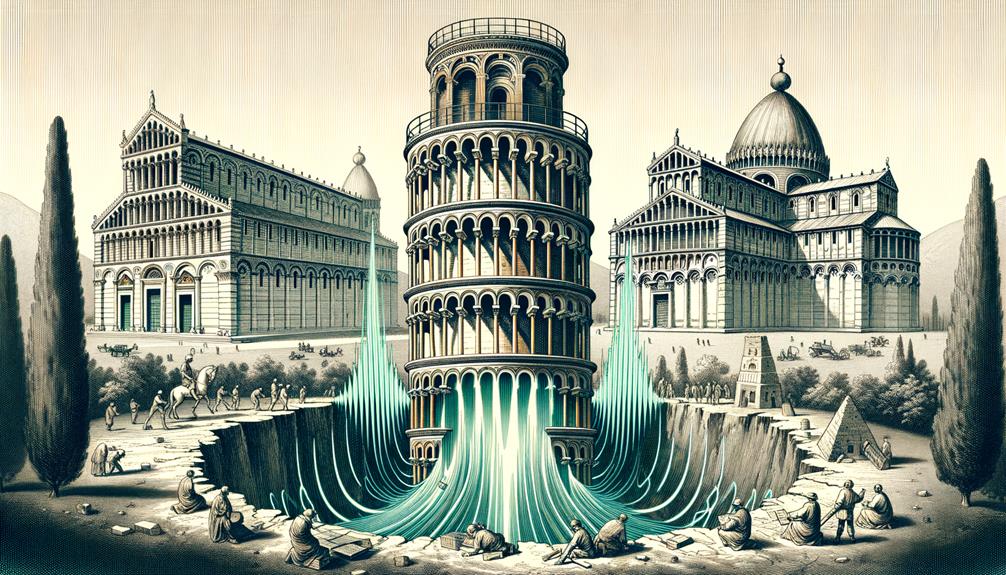
I've always been fascinated by how the Leaning Tower of Pisa manages to stay upright despite frequent earthquakes. Its clever design and the unique properties of the soil it stands on are key to its stability. Watching how it handles and disperses seismic energy, I can't help but admire the brilliant engineering behind this famous structure.
Structural Design Strength
It's fascinating how the Leaning Tower of Pisa, despite its tilt, has managed to stand strong through numerous earthquakes over the centuries. This is a testament to the clever and skilled medieval engineering behind it.
- Foundation: Though the tower's foundation is only about 3 meters deep, it features a dense network of stone and marble columns. This clever design helps to evenly distribute the tower's weight, giving it stability even during earthquakes.
- Internal Structure: The tower's hollow interior and spiral staircase aren't just for show; they help dissipate seismic energy, reducing the impact of earthquakes on the structure.
- Construction Materials: The tower's walls are made from a mix of limestone, marble, and mortar. These materials provide both strength and some flexibility, allowing the tower to absorb and withstand earthquake forces.
- Historical Earthquake Survival: The tower has survived several major earthquakes, including a 6.4-magnitude quake in 1280 and a 6.5-magnitude quake in 1546. Its ongoing survival highlights the robustness of its design and the foresight of its medieval builders.
Looking at the tower today, it's hard not to be impressed by its enduring strength against nature's powerful forces.
Soil Foundation Properties
The Leaning Tower of Pisa's ability to withstand earthquakes is largely due to its unique soil foundation, despite the ground's instability. The foundation is just three meters deep and sits on a mix of clay, fine sand, and shells. This type of soil has a low bearing capacity, which has caused the tower to sink and lean over time.
What's interesting is that this soil isn't just a problem—it's also part of the solution. While the soft ground is responsible for the tower's famous tilt, it also helps absorb and dissipate earthquake energy, lessening the impact on the structure.
Another factor is the underground water levels, which can cause the soil to settle unevenly and worsen the leaning. Nonetheless, the Leaning Tower of Pisa has survived several major earthquakes, including a 7.5-magnitude quake in 1920. It's a testament to how the same soil that makes the tower lean also helps it withstand seismic activity.
Famous Visitors

Isn't it amazing how the Leaning Tower of Pisa has drawn the attention of so many famous people over the years? Its charm is undeniable, attracting a wide range of visitors, including artists, writers, scientists, and celebrities.
Take Michelangelo, for example. The mastermind behind the Sistine Chapel couldn't help but admire the architectural wonder of the Leaning Tower. His respect for the tower speaks volumes about its artistic value. Likewise, Charles Dickens, the famed author, visited and was fascinated by its distinctive lean, incorporating his impressions into his travel writings. And let's not forget Galileo Galilei. This renowned Italian scientist, who was baptized in the nearby baptistery, is rumored to have conducted his famous gravity experiments using the tower as his testing ground.
The tower continues to be a magnet for celebrities and world leaders. From royalty to presidents, everyone wants to see this architectural marvel up close. Here's a quick rundown of some notable visitors:
- Michelangelo – Admired the tower's unique architecture.
- Charles Dickens – Featured the tower in his travel writings.
- Galileo Galilei – Conducted gravity experiments.
- Modern Celebrities – Frequently visit, adding to its appeal.
All these visitors contribute to the Leaning Tower of Pisa's legacy, making it a lasting symbol of fascination.
Climbing Experience

As I started my climb up the Tower of Pisa, I couldn't help but admire the worn marble steps, each one a testament to centuries of history. The steps seemed to tell their own stories, while the modern safety railings offered a sense of security. The mix of historical charm and contemporary safety made the climb both exciting and reassuring.
Historical Climbing Path
Climbing the Leaning Tower of Pisa, I couldn't help but notice the worn stone steps beneath my feet, each one reflecting centuries of visitors who had made the same climb. From the Tower's early days, there have been efforts to preserve its unique charm and stability. I felt a deep sense of history, thinking about all the people who had walked these steps before me. The tower, once closed to the public for safety reasons, now welcomes climbers again, offering an experience that feels both exclusive and timeless.
Climbing the tower feels like stepping back in time. Inside, the air is cool and slightly damp, with a soft echo accompanying each step. As I made my way up, the view from the narrow windows gradually expanded, showing off the beauty of Pisa below. Reaching the top was thrilling, a reward for the journey and a moment to savor.
To make the most of your climb:
- Wear comfortable shoes – The steps are steep and can be slippery.
- Take your time – Appreciate the historical significance.
- Bring a camera – The views are breathtaking.
- Visit early – Avoid the crowds and enjoy a quieter experience.
Safety Measures Overview
Climbing the Leaning Tower of Pisa, I noticed how thoughtfully handrails and non-slip surfaces were placed to keep visitors safe. As I made my way up, it became clear that a lot of effort had gone into ensuring a worry-free experience. The entire structure felt secure, reflecting the extensive work done to straighten and stabilize the tower.
Years ago, the tower was off-limits to the public due to safety concerns. During that period, engineers worked hard to fix its dangerous lean. The outcome of their efforts is evident not just in the tower's improved angle, but also in the robust safety measures now in place. It's impressive how they managed to maintain the historical charm while meeting modern safety standards.
Throughout my climb, I felt at ease knowing these safety features were quietly doing their job. The handrails were particularly helpful on steeper sections, and the non-slip surfaces let me focus on the breathtaking views instead of worrying about my footing. The safety measures are a great example of how technology and careful planning can make historical landmarks accessible and enjoyable for everyone.
Fun Facts

You might find it hard to believe, but the Leaning Tower of Pisa has been tilting for over 800 years, capturing the imagination of millions with its unique slant. Known in Italian as Pendente di Pisa, this iconic structure is probably the most famous leaning tower in the world. The tower has weathered numerous natural disasters and human interventions, making its survival even more astonishing.
Here are some interesting tidbits to further your appreciation:
- Accidental Lean: The tower started to lean during its construction in the 12th century because of unstable foundation soil. The tilt was never part of the plan; it resulted from the weak ground that couldn't properly support the structure's weight.
- Survived Wars: During World War II, the Allies considered tearing down the tower to prevent it from being used by the Germans as a lookout point. Thankfully, it was spared and continues to stand tall today.
- Galileo's Experiment: According to legend, Galileo Galilei, the renowned scientist, dropped two cannonballs of different masses from the tower to study gravity, contributing to his work on the laws of motion.
- Stabilization Efforts: Modern engineering has played a crucial role in keeping the tower from collapsing. Efforts in the 1990s reduced its tilt by about 17 inches, ensuring it remains safe for future generations to admire.
Frequently Asked Questions
What Are 5 Interesting Facts About the Leaning Tower of Pisa?
When I think about the Leaning Tower of Pisa, five cool facts come to mind. It's over 800 years old, and it leans because of unstable soil. It's survived earthquakes, took 199 years to build, and it used to be a bell tower.
Why Did the Leaning Tower of Pisa Take 200 Years?
The Leaning Tower of Pisa took a whopping 200 years to complete because the construction faced several interruptions. Wars broke out, key engineers and workers passed away, and the soft ground the tower was built on caused it to lean more and more, leading to delays and uncertainty about how to fix the problem.
Why Is the Leaning Tower of Pisa so Famous?
Over 5 million people visit it every year. Its fame mostly comes from its unintended tilt, turning what was a flawed architectural project into a symbol of human resilience and curiosity. It stands as a unique reminder that even imperfections can hold beauty.
How Many Steps Are in the Pisa Tower?
I climbed all 294 steps of the Pisa Tower, each one echoing with history and architectural genius. As I made my way up, I felt a rush of excitement from being in such a famous landmark.

